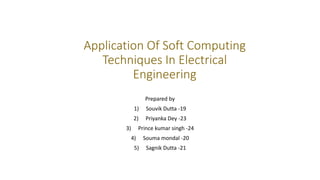Application of soft computing techniques in electrical engineering
This document discusses the application of soft computing techniques in electrical engineering. It begins with an introduction to soft computing and its key elements including fuzzy logic, neural networks, evolutionary computation, machine learning and probabilistic reasoning. It then discusses hard computing versus soft computing, defining hard computing as requiring precise analytical models and definitions, while soft computing can handle imprecision. The document outlines several soft computing techniques - neural networks, fuzzy logic, and their applications in power system economic load dispatch and generation level determination to solve complex, non-linear optimization problems in electrical engineering. In conclusion, soft computing provides alternatives to traditional techniques for electrical engineering problems involving uncertainty.

Recommended
Recommended
More Related Content
What's hot
What's hot (20)
Similar to Application of soft computing techniques in electrical engineering
Similar to Application of soft computing techniques in electrical engineering (20)
More from Souvik Dutta
More from Souvik Dutta (20)
Recently uploaded
Recently uploaded (20)
Application of soft computing techniques in electrical engineering
- 1. Application Of Soft Computing Techniques In Electrical Engineering Prepared by 1) Souvik Dutta -19 2) Priyanka Dey -23 3) Prince kumar singh -24 4) Souma mondal -20 5) Sagnik Dutta -21
- 2. INTRODUCTION • Soft Computing (SC) is an emerging field that consists of complementary elements of fuzzy logic, neural computing, evolutionary computation, machine learning and probabilistic reasoning. Due to their strong learning and cognitive ability and good tolerance of uncertainty and imprecision, soft computing techniques have found wide applications.
- 3. WHAT IS COMPUTING? • The discipline of computing is the systematic study of algorithmic processes that describe and transform information: their theory, analysis, design, efficiency, implementation, and application. The fundamental question underlying all computing is 'What can be (efficiently) automated?
- 4. WHAT IS HARD COMPUTING? • conventional computing, requires a precisely stated analytical model and often a lot of computation time. • Many analytical models are valid for ideal cases. • Real world problems exist in a non-ideal environment • Premises and guiding principles of Hard Computing are Precision, Certainty, and rigor. • Many contemporary problems do not lend themselves to precise solutions such as Recognition problems (handwriting, speech, objects, images. • Mobile robot coordination, forecasting, combinatorial problems etc.
- 5. WHAT IS A SOFT COMPUTING? • Soft computing differs from conventional (hard) computing in that, unlike hard computing, it is tolerant of imprecision, uncertainty, partial truth, and approximation. • In effect, the role model for Soft computing is the human mind. • The principal constituents, i.e., tools, techniques, of Soft Computing (SC) are – Fuzzy Logic (FL), Neural Networks (NN), Support Vector Machines (SVM), Evolutionary Computation (EC), and – Machine Learning (ML) and Probabilistic Reasoning (PR). Premises of soft computing - The real world problems are pervasively imprecise and uncertain. Precision and certainty carry a cost.Exploit the tolerance for imprecision, uncertainty, partial truth, and approximation to achieve tractability, robustness and low solution cost.
- 6. Neural Networks An Artificial Neural Network (ANN) • Ann is an information processing paradigm that is inspired by the way biological nervous systems, such as the brain, process information. • The key element of this paradigm is the novel structure of the information processing system. • It is composed of a large number of highly interconnected processing elements (neurones) working in unison to solve specific problems. • ANNs, like people, learn by example. An ANN is configured for a specific application, such as pattern recognition or data classification, through a learning process. • Learning in biological systems involves adjustments to the synaptic connections that exist between the neurones.
- 7. Fuzzy Logic (FL) • Fuzzy logic is a problem-solving control system methodology. • Implementation in systems ranging from simple, small, embedded micro-controllers to large, networked, multi-channel PC or workstationbased data acquisition and control systems. • It can be implemented in hardware, software, or a combination of both. • FL provides a simple way to arrive at a definite conclusion based upon vague, ambiguous, imprecise, noisy, or missing input information. • FL's approach to control problems mimics how a person would make decisions, only much faster.
- 8. APPLICATIONS OF SOFT COMPUTING Power system Economic Load Dispatch (ELD) -is the process of allocating generation among the available generating units, subject to load and other operational constraints, 1. such that the cost of operation is a minimum. 2. It is essential for real-time control of power system operation. 3. The traditional Static Economic Dispatch (SED) formulation does not assure the exact satisfaction of the previously defined constraints on the dynamics of power generation. 4. The output of a static procedure is a sequence of separate optimal points, which do not take into account the existing dynamic connections among the system state variables during the optimization interval
- 9. For proper scheduling of modern power plants, • involving non-linearities and discontinuities in the generator cost curves due to valve point loadings and other reasons, the classical optimization techniques, based on partial derivatives, do not perform satisfactorily. • Recently, modern meta-heuristic algorithms i.e. Genetic Algorithm (GA), Fuzzy Systems (FS) ,Evolutionary Programming (EP) ,Simulated Annealing (SA) ,Evolutionary Strategy (ES), Particle Swarm Optimization (PSO) ,Differential Evolution (DE) etc are considered as effective tools for nonlinear optimization problems concerning applications to electrical power systems.
- 10. • The algorithms do neither require the objective functions nor the constraints have to be differentiable and continuous. • Multi objective optimization problem comprises of both fuel cost and emission cost functions . Multi objective differential evolution (MODE) follows a diverse set of solutions converging near the true Pareto-optimal set.
- 11. Determination of Generation Levels In this approach,
- 12. Conclusion • In this paper we have given an Soft Computing Techniques, applications and future of Soft Computing. The present paper can provide the readers a better understanding about Soft Computing and techniques and the topic is open to further research.
